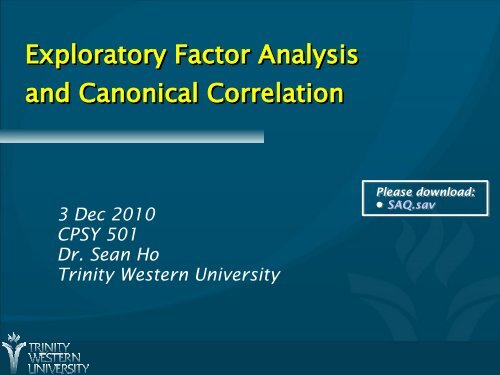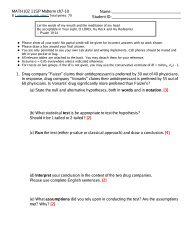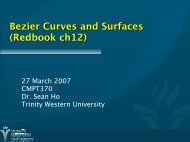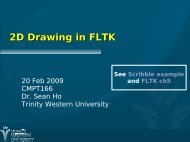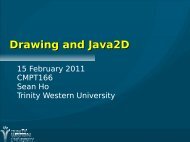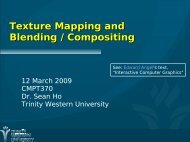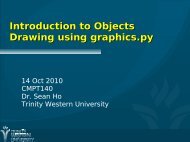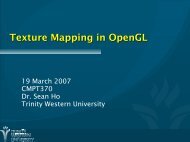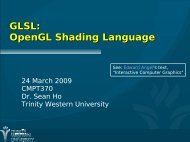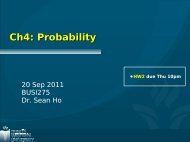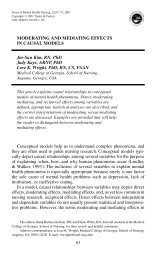Exploratory Factor Analysis and Canonical Correlation
Exploratory Factor Analysis and Canonical Correlation
Exploratory Factor Analysis and Canonical Correlation
- No tags were found...
Create successful ePaper yourself
Turn your PDF publications into a flip-book with our unique Google optimized e-Paper software.
Outline for today <strong>Factor</strong> analysis● Latent variables● <strong>Correlation</strong> (“R”) matrix● <strong>Factor</strong> extraction● Rotation● Assumptions● Example in SPSS <strong>Canonical</strong> correlation … <strong>and</strong> how it explains all! Structural Equation Modeling● Path analysis + factor analysisCPSY501: EFA <strong>and</strong> Canon.Corr.3 Dec 20102
Latent vars: Eysenck's factors Eysenck Personality Questionnaire (EPQ-R, 1985):● 100 yes/no questions (observed)● 3 underlying (latent) dimensions of personalityTalkativeAnxiousUnsympatheticImpulsiveRisk-takingObsessiveAggressiveAchievingExtroversionvs. IntroversionNeuroticismvs. StabilityPsychoticismvs. SocialisationCPSY501: EFA <strong>and</strong> Canon.Corr.3 Dec 20104
Linear factor analysis Define factors as linear combos of observed vars:● F 1= b 1X 1+ b 2X 2+ … + b nX n● b iare the loadings of F 1on the observed X i● If X idoes not contribute to F 1, then b i= 0 <strong>Exploratory</strong> <strong>Factor</strong> <strong>Analysis</strong>:● No prior theory: find the factors from the vars● Sample = pop: results may overfit to data Confirmatory <strong>Factor</strong> <strong>Analysis</strong>:● Already know the factors (from EFA, or theory)● Test their predictive power on larger datasetCPSY501: EFA <strong>and</strong> Canon.Corr.3 Dec 20105
Why use EFA? Parsimony: eliminate redundant vars <strong>and</strong> those withlittle variation (reduce 100's → 10's of vars)● c.f. multiple regression “backward selection”:drop non-significant IVs from model (for DV) But in EFA there is no DV, just a collection of IVs● Combining similar/redundant variables may beuseful for enhanced reliability● Simplify variables for subsequent analysis Discover latent variables, construct new theory:● Group together highly inter-correlated variables● Interpretability of factors is key!CPSY501: EFA <strong>and</strong> Canon.Corr.3 Dec 20106
<strong>Factor</strong>s in the R matrix The “R matrix” is the matrix of correlations betweenall pairs of (observed) variables● Symmetric, <strong>and</strong> all entries on diagonal are 1 Groups of highly-correlated variablesare good c<strong>and</strong>idates for factors● Combine several variables into one factor● Internal consistency: Cronbach's α1 0.20 0.11 0.15Potentialfactor0.20 1 0.85 0.910.11 0.85 1 0.930.15 0.91 0.93 1CPSY501: EFA <strong>and</strong> Canon.Corr.3 Dec 20108
Multivariate normal distribution (Pearson) correlation assumes normality● Although EFA is fairly robust to non-normality For multiple vars: multivariate normal distribution● Quartiles, etc. form ellipsoids around mean● Area of ellipsoids ↔ determinant of R matrix Multi-collinearity: some vars nearly perfect correl.● Ellipsoids become squashed; det(R) → 0CPSY501: EFA WikiMedia<strong>and</strong> Canon.Corr.3 Dec 2010GA Tech9
<strong>Factor</strong> extractionNZ Gov Each factor is an axisthrough the data PCA extracts one factor at a time:● PC1 is the longest axis of the ellipsoid:capture as much variance in vars as possible● PC2 is longest axis perpendicular to PC1:capture as much leftover variance as possible● Etc.: capture most of variance w/just a few PCs PAF is similar but only cares about the portion ofvariance which is shared with other variables● Uses R matrix but diagonals are %shared var● Useful for exploration, development of theoryCPSY501: EFA <strong>and</strong> Canon.Corr.3 Dec 2010 10
Communality <strong>and</strong> eigenvalues Linear combinations of variables:● F 1= b 11X 1+ b 12X 2+ … + b 1nX nF 1F 2X 1b 11b 21X● F 2= b 21X 1+ b 22X 2+ … + b 2nX 2b 12b 22n... ... ... <strong>Factor</strong> matrix lists the loadingsX nb 1nb 2n Communality of a variable is% of its variance explained by the selected factors● Sum of squared loadings across the factors Eigenvalue of a factor is% of total variance explained by that factor● Sum of squared loadings across all variables● PCs extracted in descending order by eigenvalCPSY501: EFA <strong>and</strong> Canon.Corr.3 Dec 2010 11
How many factors to use? Guided by theory: # underlying dimensions● Can you underst<strong>and</strong>/interpret each factor? Kaiser's criterion: eigvals < 1 → unstable factors Not adding appreciably to total explained variance If a (theoretically) important variable haslow communality, may want more factors to captureits variance Scree plot: eigenvaluesof successive factorsCPSY501: EFA <strong>and</strong> Canon.Corr.3 Dec 2010 12
Rotation <strong>Factor</strong>s as extractedusing PCA or PAF are often difficult to interpret● Each variable may show up in several factors Rotation can shuffle the extracted factors to easeinterpretation Several methods of rotation. The most common:● Varimax (orthogonal): minimise #factors each varshows up in (“Are you in or out?”)● Oblimin (oblique): increases eigenvalues byallowing factors to be a bit correlated (use δ) → in psychology, latent vars are rarely uncorrelated!CPSY501: EFA <strong>and</strong> Canon.Corr.3 Dec 2010 13
Assumptions for EFA Sufficient sample size● 300 or more; rule of thumb is ~20 per var● Kaiser-Meyer-Olkin (r 2 / partial-r 2 ) close to 1● Diagonals of anti-image correlation matrix >0.5(drop any vars 0.5)● Bartlett's test of sphericity (tests for goodness): ifR matrix differs significantly from identity,i.e., off-diagonal entries not all zeroCPSY501: EFA <strong>and</strong> Canon.Corr.3 Dec 2010 15
EFA in SPSS: SAQ.sav Dataset: SAQ.sav (artificial data from textbook)● 23 questions on “SPSS anxiety” (5pt-Likert) EFA: Analyze → Dimension Reduction → <strong>Factor</strong>● Variables: select all 23 questions Descriptives: <strong>Correlation</strong> Matrix:● Coeffs, Det., Anti-image, KMO+Bartlett Extraction: Method → Principal Components● Display: Unrotated, Scree; Extract: Eigvals >1 Rotation: Varimax; Display: Rotated, Loading plot Options: Sort, Suppress
Interpreting output: SAQ.sav Assumptions: correlation matrix● Ensure each var has several |r| > 0.3 Should really look at significance of correl., too● Determinant not close to 0? (multi-collinearity) Diagonal entries of anti-image: >0.5? KMO close to 1? Bartlett's test? (sig is good)CPSY501: EFA <strong>and</strong> Canon.Corr.3 Dec 2010 17
Interpreting output: factors How many factors were selected?● Total Variance Explained● Scree plot Component Matrix: shows unrotated loadings Rotated Component Matrix:● Each var should show up in only 1 or 2 factors● We asked for cut-off at 0.4● <strong>Factor</strong>s indicate groupings of vars <strong>and</strong> relativeimportance of each var within a grouping Try to interpret the factors? Fear of computers, fearof stats, fear of math, peer evaluationCPSY501: EFA <strong>and</strong> Canon.Corr.3 Dec 2010 18
EFA summary A way of reducing the number of variables<strong>and</strong> finding underlying structure● <strong>Factor</strong>s are linear combinations of the variables Extraction: one factor (axis) at a time● Largest eigenvalues first● PCA: total variance, good for variable reduction● PAF: shared variance, good for theory explor. Rotation: to ease interpretation of the factors● Varimax: orthogonal, each var in 1-2 factors● Oblimin: oblique, may reflect theory betterCPSY501: EFA <strong>and</strong> Canon.Corr.3 Dec 2010 19
<strong>Factor</strong> <strong>Analysis</strong>: References Kristopher J. Preacher & Robert C. MacCallum(2003).Repairing Tom Swift’s Electric <strong>Factor</strong> <strong>Analysis</strong>Machine.Underst<strong>and</strong>ing Statistics, 2(1), 13–43. Anna B. Costello & Jason W. Osborne (2005).Best Practices in <strong>Exploratory</strong> <strong>Factor</strong> <strong>Analysis</strong>: FourRecommendations for Getting the Most From Your<strong>Analysis</strong>.Practical Assessment Research & Evaluation, 10(7),1-9.MANOVA4 Dec 2010 20
Outline for today <strong>Factor</strong> analysis● Latent variables● <strong>Correlation</strong> (“R”) matrix● <strong>Factor</strong> extraction● Rotation● Assumptions● Example in SPSS <strong>Canonical</strong> correlation … <strong>and</strong> how it explains all! Structural Equation Modeling● Path analysis + factor analysisCPSY501: EFA <strong>and</strong> Canon.Corr.3 Dec 2010 21
<strong>Canonical</strong> correlation Hotelling, 1936: an idea to help underst<strong>and</strong> manyanalyses: multiple regression, MANOVA, EFA, etc. Two groups of variables X i<strong>and</strong> Y j(not necc. IV/DV) Let U, V be linear combinations of the X i<strong>and</strong> Y j:● U = b 1X 1+ b 2X 2+ … + b mX m● V = a 1Y 1+ a 2Y 2+ … + a nY n The first canonical pair is the (U 1,V 1) which havemax correlation; this corr. is 1st canonical corr.X 1, X 2, …, X mU 1↔ V 1Y 1, Y 2, …, Y nCPSY501: EFA <strong>and</strong> Canon.Corr.3 Dec 2010 22
<strong>Canonical</strong> corr. <strong>and</strong> regression Second canonical pair is the (U 2,V 2) which areorthogonal to (U 1,V 1) <strong>and</strong> maximize correlation● 3 rd canonical pair, 3 rd canonical correlation, etc.● # canonical pairs = min(#X, #Y) = min(m, n) Multiple regression is a special case:● Only one Y → only one canonical pair (U,V)● The canonical correlation is R (→ R 2 !)● Coefficients of U are the b's (slopes)!CPSY501: EFA <strong>and</strong> Canon.Corr.3 Dec 2010 23
<strong>Canonical</strong> corr. <strong>and</strong> MANOVA MANOVA: multiple DVs → multiple canon. corrs.● Each V kis a linear combo of the DVs:→ they are factors of the DVs!● Different from EFA, in that the factors are chosento maximize correlation of Xs with Ys● Optimal factor of the IVs, plusoptimal factor of the DVs → to maximize correl. <strong>Canonical</strong> factor loadings: correlation between avariable (X ior Y j) <strong>and</strong> one of its factors (U kor V k)● These are equivalent to factor loadings in EFACPSY501: EFA <strong>and</strong> Canon.Corr.3 Dec 2010 24
Outline for today <strong>Factor</strong> analysis● Latent variables● <strong>Correlation</strong> (“R”) matrix● <strong>Factor</strong> extraction● Rotation● Assumptions● Example in SPSS <strong>Canonical</strong> correlation … <strong>and</strong> how it explains all! Structural Equation Modeling● Path analysis + factor analysisCPSY501: EFA <strong>and</strong> Canon.Corr.3 Dec 2010 25
Structural Equation Modelling A way to do regression on latent variables SEM = Path analysis + <strong>Factor</strong> analysis● Structural model + Measurement model Structural model: causal links between variables● Vars may serve as both IV <strong>and</strong> DV(simultaneous equation analysis: econometrics) Measurement model:● Latent variables underlying the observed vars SEM may be exploratory: don't know structure, don'tknow latent vars (EFA) Or confirmatory: theory tells structure, latent varsCPSY501: EFA <strong>and</strong> Canon.Corr.3 Dec 2010 26
SEM: Path analysis Path diagrams indicate causation amongst vars● E.g., mediation diagram Often group vars as: Inputs → Processes → Output May be built from theory (confirmatory analysis)● Or derived from correlations in the data(exploratory analysis) (might not generalize)Input Processes OutputGeneticsPsycho-somaticBehaviouralEnvironmentalCopingAnxietyEmotionalTraumaBeliefsSocializationRelationalCPSY501: EFA <strong>and</strong> Canon.Corr.3 Dec 2010 27
SEM: Simultaneous equations Originally developed for econometrics theory Exogenous vars serve only as IVs (inputs) Endogenous vars are DV or both (process, output)● Y 1= a 11Y 1+ a 12Y 2+ b 10+ b 11X 1+ b 12X 2+ …● Y 2= a 21Y 1+ a 22Y 2+ b 20+ b 21X 1+ b 22X 2+ … In matrix form: Y = α + BY + ΓX● Y: vector of endogenous variables(plus resids)● X: vector of exogenous variables● α: vector of intercepts● B: matrix of endogenous inter-relationships● Γ: matrix relating exogenous → endogenousCPSY501: EFA <strong>and</strong> Canon.Corr.3 Dec 2010 28
SEM: putting it together SEM = Path analysis + <strong>Factor</strong> analysis The vars X, Y in the simultaneous equations neednot be observed vars: can be latent vars (factors) Measurement model maps observed vars onto latentvars via factor loadings (either EFA or CFA) Model estimation step:● Build structural model (path diagram) w/latents● Build measurement model from observed vars Model testing step (goodness of fit): χ 2 , AIC, etc. Repeat to refine modelCPSY501: EFA <strong>and</strong> Canon.Corr.3 Dec 2010 29
SEM: steps for modellingTheorySpecifyInitialModelData <strong>and</strong>MeasuresEstimation:Structure +MeasurementTesting:Goodness of FitInterpretationRefineModelCPSY501: EFA <strong>and</strong> Canon.Corr.3 Dec 2010 30


